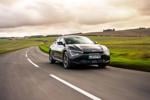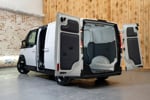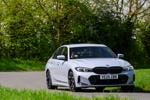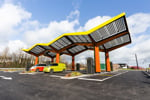Review
Just in case anyone hasn’t noticed recently, Honda is thinking differently nowadays. The advertising says it all with its inventive, eye-catching and sometimes whacky approach.
Often, it isn’t even selling a car, just an engine, or even a concept, such as the campaign which asked ‘what if?’.
Over seven generations, the Civic has sold 16 million units (more than one-third of all Honda sales) and it has recently appeared the top 10 best-selling petrol cars in the UK fleet market.
For the new Civic the designers were sent to Milan and told to create a look which would stand out even among the fashion-conscious residents of the Italian city.
How it looks in Barnsley on a rainy Saturday is another matter, or even Swindon, where it is built, but it has already wowed the motoring world, stealing the limelight as a concept car at the Geneva Show earlier this year.
The new Civic will be launched in the UK in January next year in five-door format, with a three-door to appear later in the year, along with a four-door hybrid version, exclusively revealed on Fleet NewsNet last month.
Once the entire range is available there should be about 100,000 sales a year in Europe, with 35,000 in the UK. Corporate buyers should take about 40% of sales.
Honda is pitching the car against the Alfa Romeo 147, Volkswagen Golf, Audi A3 and BMW 1-series, and at a much younger buyer base.
It doesn’t want to alienate the current average buyer, who is 50, but intends to bring the average driver age down to between 30 and 50 with the new model, with half of drivers being women, compared to just a third at present.
Prices will be announced at the Frankfurt Motor Show in September.
Engines and transmissions
THERE will be three engines at launch, a 1.4 and an all-new 1.8-litre petrol engine and the 2.2-litre diesel used extensively throughout the range.
Only about 15% of buyers are expected to opt for the 1.4, with the larger 1.8 petrol set to account for 45% of sales. As well as offering better performance, its extra fuel thirst and emissions are minimal – the 1.8 returns 2mpg less than the 1.4 and CO2 emissions are 149g/km, compared to 143g/km.
While the 2.2-litre diesel will only gain 40% of overall sales, in fleet it will take the majority, especially when it returns 55.4mpg and 135g/km of CO2. A six-speed manual gearbox is standard on all models, with an optional six-speed automated manual on the petrol cars. Service intervals are 12,500 miles and rust protection warranty rises from six to 12 years.

Interior
THE interior, like the rest of the car, is a radical departure from the current model, in particular the ‘dual zone’ cockpit area. It has centrally located major instruments, including a starter button and a peripheral area behind the main console just under the windscreen carrying information including your speed, so you don’t have to take your eyes off the road.
The lower panel behind the steering wheel houses a pod with warning lights and information, which is surrounded by the rev counter.
Equipment levels are yet to be decided, but top models will feature both automatic lights and windscreen wipers.
The rear seats split 60/40 and also feature the fold flat/tip up function pioneered in the Jazz, while there is a two position boot floor.
The boot is roomy even with the seats up, at 415 litres, but with the lower compartment extends to 485 litres, more than 100 litres bigger than key competitors. All Civics are equipped with anti-lock brakes with electronic brake force distribution (EBD) which adjusts all wheel brake effort to achieve maximum braking performance and stability.
The new Civic also features vehicle stability assist (VSA), designed to assist the driver in maintaining control during cornering, acceleration and sudden manoeuvres by applying brake force to the right or left hand wheels as necessary and managing the throttle and brake systems.
Honda is expecting a five-star rating from the European New Car Assessment Programme crash tests.
Styling
WHILE the new Civic is wider and lower than the old model, it is also shorter and thinner. Overall length is now 4,250 mm, down 35mm, so it is longer than a Volkswagen Golf (4,204mm), but shorter than a Ford Focus (4,342mm) and about the same as a Vauxhall Astra (4,249mm). Overall height is 1,460 mm (down 35 mm).
However, width is 1,760mm, a rise of 65mm.

Honda aimed to create a car with a sporty and futuristic look, so the five-door has hidden rear door handles, and the rear has twin exhaust pipes, even though only one is used.
The headlamps merge into a glazed front panel, a design feature mirrored at the rear, where there is also a lip in the window that acts as a spoiler.
Despite the absence of a rear wiper, Honda insists the Civic’s aerodynamic shape removes the need for one. Nice touches include indicator repeaters in the wing mirrors and windscreen wipers which fold out in opposite directions.
Honda Civic fact file
| Model: | 1.4 i-DSI | 1.8 i-VTEC | 2.2 i-CTDi | |||
| Max power (bhp/rpm): | 82/5,700 | 138/6,300 | 138/4,000 | |||
| Max torque (lb-ft/rpm): | 88/2,800 | 128/4,300 | 251/2,000 | |||
| Max speed (mph): | 107 | 129 | 128 | |||
| 0-62mph (sec): | 14.2 | 8.6 | 8.4 | |||
| Fuel consumption (mpg): | 46.3 | 44.1 | 55.4 | |||
| CO2 emissions (g/km): | 143 | 149 | 135 | |||
| On sale: | January | |||||
| Prices (est): | £13,000–£18,000 | |||||
















